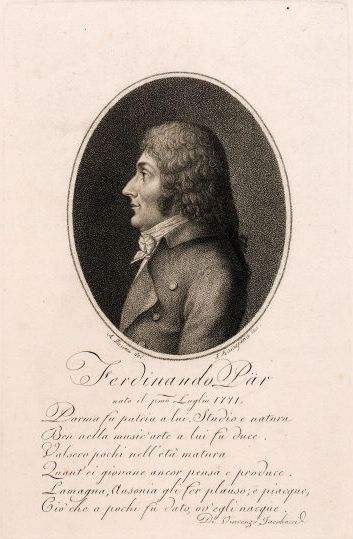
Paer around 1805
Agnese, an opera ... in the madhouse
Agnese is a semi-serious opera in two acts that stages human folly. The plot unfolds almost entirely within an asylum, where the main character Uberto is confined, gone mad after his daughter Agnese abandoned him to escape with her lover Ernesto.
In this opera scenes of madness are very intense, inspired by Paisiello’s Nina, they anticipate the more famous ones of Bellini’s Il pirata and I puritani and Donizetti’s Lucia di Lammermoor by twenty years. Agnese impressed the most important critics and musicians of the time, such as Berlioz, Chopin, Castil-Blaze and deeply influenced the new generation of opera composers. However, there were also those who were shocked by the topic: Stendhal, for example, declared himself horrified and disgusted by the opera, because it so crudely and realistically staged the sad condition of human folly.
This crude and unsettling subject does however lead to a happy ending, as the affection of Agnese, returned to her father, will eventually save Uberto and help him recover ...
Madness and filial love in music
The music is rich in effects and the pantomime moments well convey the disturbance of mental illness: the madness scenes of Uberto - «Quando lo troverò» and «Se fur sogno i miei tormenti» - make for the musical climaxes of the score. Also the filial love and the intense father-daughter relationship, expressed in the duet «Quel sepolcro che racchiude» and in Agnese’s prayer «Il padre, o Ciel, mi rendi», are underlined with melancholic and almost pre-Bellinian melodies. But Paer is also careful not to neglect the tormented love between Agnese and Ernesto, showing considerable musical finesse and acute dramatic sensitivity; especially in the duets of forgiveness «A questo sen ritorna» and «L’amato padre mio». Finally, there are the brilliant and humorous moments, linked in particular to the “buffo” Don Pasquale - the aria «Bella cosa è l’esser padre» and the duet «Sì, capisco; ora v’intendo» - that give the whole opera its endearing semi-serious balance.
Paer employs a large tonal palette. In particular he emphasizes the minor mode, used for example for the impressive choral scene of the initial storm «Agnese misera» (D minor), in the melancholic cantabile «Agnese io ti perdei» in Uberto’s cavatina (A minor) and still in the sad Uberto’s romance «Come la nebbia al vento» (G minor).
The orchestration, finally, offers a pleasant variety of tone colors, also highlighted by the richness of pieces with concertante instruments, such as Ernesto’s aria «Cielo, pietoso cielo» and Agnese’s prayer «Il padre, o Ciel, mi rendi», both with Solo clarinet, Uberto’s scena e aria «Se fur sogno i miei tormenti» with two Solo horns as well as the romance in the Finale II «Se la smarrita agnella» accompanied by the harp.
